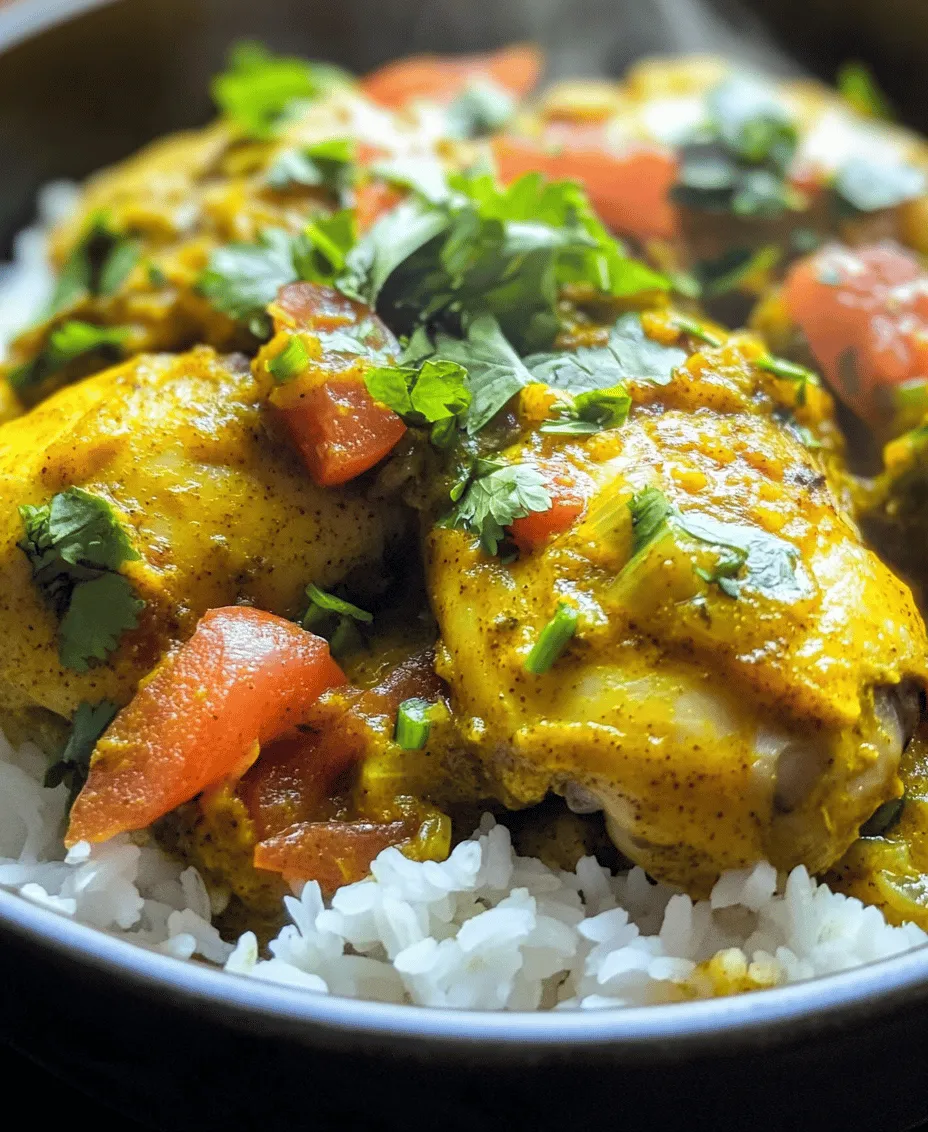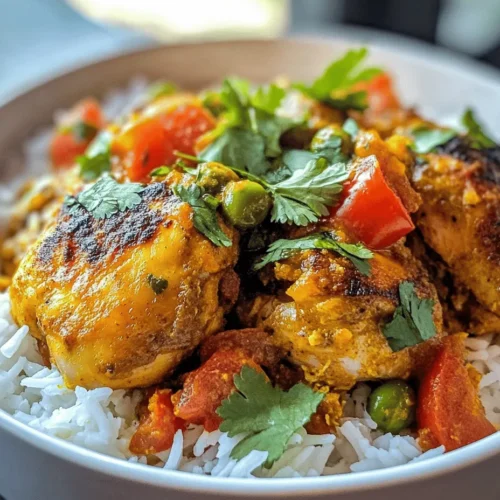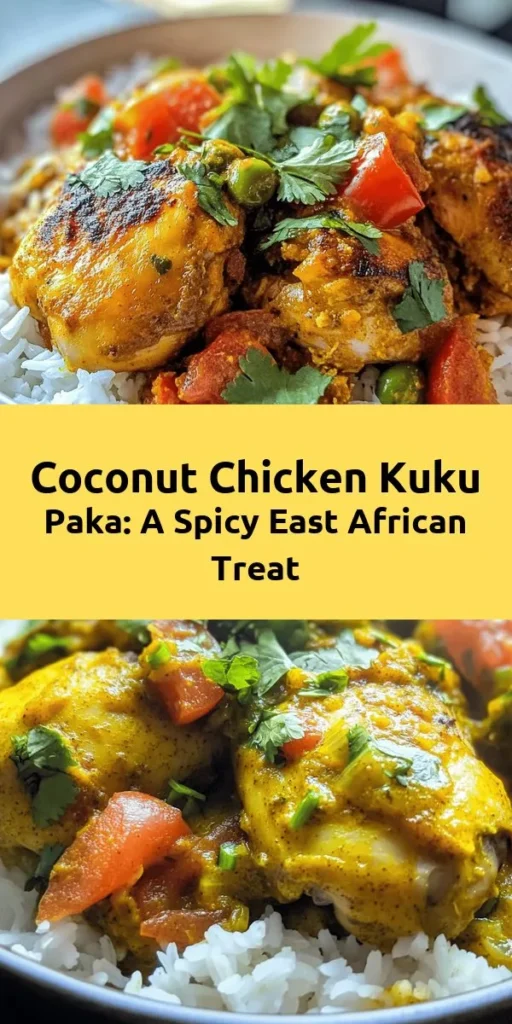Introduction to Kuku Paka: A Taste of East Africa
Kuku Paka, a beloved dish from East Africa, specifically hails from the coastal regions of Kenya and Tanzania. This delightful coconut chicken curry has etched its place in the hearts and kitchens of many, transcending borders and captivating food enthusiasts around the globe. With its roots deeply embedded in Swahili culture, Kuku Paka symbolizes the rich culinary traditions that celebrate the use of fresh, local ingredients and vibrant spices. The word “Kuku” translates to “chicken” in Swahili, while “Paka” means “to smear,” referring to the luscious coconut sauce that envelops the chicken.
This dish is more than just a meal; it is a cultural experience that invites you to savor the flavors of East Africa. The combination of succulent chicken cooked in a creamy coconut sauce infused with aromatic spices creates a fusion of tastes that is both comforting and exotic. Whether enjoyed at family gatherings, festive occasions, or simply shared among friends, Kuku Paka has a unique ability to bring people together, making it a staple in many homes.
The appeal of Kuku Paka lies not only in its incredible taste but also in its versatility. It can be served with rice, chapati, or even enjoyed on its own, making it a flexible option for various palates and dietary preferences. With the rise of global interest in diverse cuisines, Kuku Paka has gained popularity outside East Africa, enticing chefs and home cooks alike to explore its rich flavors and history.
Understanding the Ingredients of Kuku Paka
As with any traditional recipe, the magic of Kuku Paka lies in its carefully selected ingredients. Each component contributes to the overall flavor profile and texture of the dish, creating a harmonious balance that delights the senses. Here’s a closer look at the essential ingredients that make Kuku Paka a truly exceptional coconut chicken dish.
Chicken Thighs
The foundation of Kuku Paka is undoubtedly the chicken, and for this recipe, skinless and boneless chicken thighs are the preferred choice. Unlike chicken breasts, which can easily dry out, thighs offer a richer flavor and a more tender texture when cooked. The higher fat content in thighs ensures that they remain juicy throughout the cooking process, making each bite a succulent experience. Additionally, marinating the chicken enhances its flavor, allowing the spices to penetrate the meat, resulting in a dish that is bursting with taste.
Coconut Milk
Coconut milk plays a pivotal role in Kuku Paka, serving as the creamy base that enriches the dish and imparts a tropical flair. Its smooth texture and subtle sweetness perfectly complement the spices, creating a luxurious sauce that envelops the chicken. Coconut milk is not only delicious but also packed with health benefits; it contains healthy fats that provide energy and support heart health. Furthermore, it is a dairy-free alternative, making Kuku Paka suitable for those with lactose intolerance or following a vegan lifestyle.
Aromatics
The depth of flavor in Kuku Paka is achieved through the use of aromatics such as onions, garlic, and ginger. These ingredients are the backbone of the dish, adding complexity and enhancing the overall taste. Onions, when sautéed until golden brown, release their natural sweetness, which balances the spices and adds richness. Garlic and ginger contribute their distinctive flavors, providing warmth and a hint of spiciness that elevates the dish to new heights.
Spices
The spices used in Kuku Paka are what truly set it apart from other chicken dishes. Turmeric, garam masala, and coriander powder are the stars of this recipe, each bringing its unique flavor and health benefits. Turmeric, known for its vibrant color and anti-inflammatory properties, adds a warm earthiness to the dish. Garam masala, a blend of various spices, offers a complex flavor profile that is both aromatic and savory. Coriander powder adds a citrusy note that brightens the dish, making it a perfect complement to the richness of the coconut milk.
Fresh Ingredients
To achieve the perfect balance of flavors, Kuku Paka incorporates fresh ingredients like tomatoes, green chilies, lime juice, and cilantro. Tomatoes not only provide acidity, which helps to cut through the richness of the coconut milk but also contribute to the overall texture of the sauce. Green chilies add a kick of heat, allowing you to customize the spice level to your liking. Lime juice brightens the dish, enhancing the flavors and giving it a refreshing finish. Finally, fresh cilantro adds a burst of color and a herbal note that rounds off the dish beautifully.
Preparation Steps for Spicy East African Kuku Paka
Now that we’ve explored the essential ingredients that make Kuku Paka a standout dish, let’s delve into the preparation steps. The process of making this coconut chicken delight is straightforward yet requires attention to detail to ensure optimal flavors and textures. Here’s how to prepare Spicy East African Kuku Paka:
Marinating the Chicken
The first step in creating a flavorful Kuku Paka is marinating the chicken. This process is crucial as it allows the spices to infuse into the meat, enhancing its taste and tenderness. To marinate the chicken thighs, combine turmeric, garam masala, coriander powder, salt, and a splash of lime juice in a bowl. Coat the chicken evenly with the mixture, ensuring each piece is well-covered. Cover the bowl and let the chicken marinate for at least 30 minutes, or longer if time permits. The longer the chicken sits in the marinade, the more pronounced the flavors will be.
Sautéing Aromatics
Once the chicken has marinated, it’s time to prepare the aromatics. In a large, heavy-bottomed pot or skillet, heat a generous amount of oil over medium heat. Add finely chopped onions and sauté them until they become golden brown, stirring frequently to prevent burning. This step is essential, as caramelizing the onions brings out their natural sweetness and creates a rich flavor base for the dish. After the onions have reached the desired color, add minced garlic and ginger, sautéing for an additional minute until fragrant.
Cooking the Chicken
With the aromatics prepared, it’s time to cook the marinated chicken. Add the chicken thighs to the pot, ensuring they are spaced out to allow for even cooking. Allow the chicken to brown on all sides, which helps to seal in the juices and develop a rich flavor. This step is crucial as it creates a delicious crust on the chicken, adding depth to the final dish. Once the chicken is browned, remove it from the pot and set it aside.
Incorporating Tomatoes and Spices
Next, it’s time to incorporate fresh tomatoes and the remaining spices into the pot. Add diced tomatoes to the pot, stirring them in with the sautéed aromatics. As the tomatoes cook down, they will release their juices, creating a flavorful base for the sauce. After the tomatoes have softened, return the browned chicken to the pot, mixing everything together. This step not only enhances the dish’s flavor but also allows the chicken to absorb the tanginess of the tomatoes.
The Magic of Coconut Milk
Once the chicken and tomatoes are well combined, it’s time to add the star ingredient: coconut milk. Pour in the coconut milk, stirring gently to combine with the other ingredients. At this stage, you may want to adjust the consistency of the sauce by adding a bit of water if it appears too thick. Allow the mixture to come to a gentle simmer, ensuring that the flavors meld together beautifully. The simmering process is essential, as it allows the chicken to cook through while soaking up the creamy goodness of the coconut milk.
Final Cooking Stage
Finally, let the Kuku Paka simmer on low heat for about 20-30 minutes or until the chicken is tender and fully cooked. It’s important to check the chicken for doneness, ensuring it reaches an internal temperature of 165°F (74°C). During the final cooking stage, taste the sauce and adjust the seasoning as needed, adding salt, lime juice, or more spices to suit your preference. The result should be a tender chicken enveloped in a rich, flavorful coconut sauce that is both comforting and satisfying.
As you prepare this Spicy East African Kuku Paka, the enticing aromas will fill your kitchen, promising a culinary journey that celebrates the vibrant flavors of East Africa. Stay tuned for the next part of this article, where we will explore tips for achieving the best results and address common questions about this delightful dish.

Serving Suggestions for Kuku Paka
Kuku Paka, with its rich and flavorful profile, is a versatile dish that pairs wonderfully with various accompaniments. Traditionally, it is served with rice, chapati, or naan, each of which complements the creamy coconut sauce beautifully. The choice of side can enhance the overall dining experience by balancing flavors and textures.
For a classic approach, serve Kuku Paka with steamed basmati rice, which absorbs the savory coconut sauce, making each bite a delight. Chapati, a type of unleavened flatbread, is perfect for scooping up the chicken and sauce, providing a satisfying chewiness that contrasts with the creaminess of the dish. Alternatively, naan, with its soft and pillowy texture, can add an element of indulgence.
Presentation Tips: Elevate your Kuku Paka by garnishing it with fresh cilantro or parsley just before serving. A sprinkle of finely chopped green chili can add a pop of color and an extra kick. Serve the dish in a shallow bowl to showcase the vibrant colors of the sauce and chicken. For a touch of elegance, place a wedge of lime or lemon on the side; the citrus can brighten the meal when squeezed over the top.
Pairing Options: In addition to the traditional sides, consider pairing Kuku Paka with a simple cucumber salad to add a refreshing crunch. This can help cut through the richness of the coconut milk. For beverages, a chilled glass of mango lassi or ginger ale can provide a sweet contrast, enhancing the overall meal experience.
Nutritional Benefits of Kuku Paka
Kuku Paka is not only a delicious dish but also a nutritious one. A typical serving offers a balanced breakdown of essential nutrients. Here’s a closer look at the nutritional benefits per serving:
– Calories: Approximately 350-450 calories, depending on the portion size and ingredients used.
– Protein: Chicken is an excellent source of lean protein, essential for muscle repair and growth. A serving typically contains about 25-30 grams of protein.
– Healthy Fats: Coconut milk is rich in medium-chain triglycerides (MCTs), which are beneficial fats that can provide quick energy and support metabolic health. A serving contains around 15 grams of healthy fats.
– Carbohydrates: When served with rice or chapati, the dish also provides a good source of carbohydrates, which are vital for energy. A serving with rice can contribute approximately 40-50 grams of carbohydrates.
Key ingredients in Kuku Paka also come with their own set of health benefits. Coconut milk is known to support heart health due to its high levels of lauric acid, which can help reduce harmful cholesterol levels. The spices used in the dish, such as turmeric and cumin, not only add depth of flavor but also have anti-inflammatory properties and antioxidant benefits.
Exploring Variations of Kuku Paka
Kuku Paka is a dish that showcases the diverse culinary traditions of East Africa, with numerous regional variations. In Kenya, for example, you may find Kuku Paka with a spicier profile, emphasizing local chili varieties, while in Tanzania, a milder version might be preferred, focusing more on the coconut’s natural sweetness.
For those looking for vegetarian alternatives, you can easily substitute chicken with plant-based proteins such as tofu, tempeh, or even chickpeas. These alternatives can soak up the flavors of the coconut sauce just as well, providing a satisfying meal without the meat.
Spicing It Up: Customize the heat level of your Kuku Paka by adjusting the amount of chili used. For a milder dish, reduce the number of chilies or opt for sweet red bell peppers instead. If you prefer a spicier kick, consider incorporating cayenne pepper or Sriracha into the sauce. You can also experiment with spice blends, adding ingredients like coriander, cardamom, or allspice for a unique twist on the traditional flavor profile.
Cultural Context and History of Kuku Paka
Kuku Paka holds a significant place in East African cuisine, showcasing the region’s rich culinary heritage. The dish is believed to have originated from the Swahili coast, influenced by the culinary practices of Indian and Arab traders who settled in the area. This fusion of flavors reflects the diverse cultures that have come together over centuries in East Africa.
The name “Kuku Paka” translates to “chicken with coconut” in Swahili, and it embodies the essence of coastal cuisine, where fresh ingredients and vibrant spices reign supreme. The dish has evolved over time, becoming a staple at family gatherings, festive occasions, and celebrations.
Many families have their own cherished recipes passed down through generations, each adding their unique touch to the dish. In celebrations, Kuku Paka often takes center stage, symbolizing hospitality and abundance, inviting friends and family to gather and savor the flavors of home.
Conclusion: Embrace the Flavors of Kuku Paka
Kuku Paka is more than just a meal; it’s a celebration of East African culture and culinary traditions. Its unique combination of tender chicken, creamy coconut milk, and aromatic spices creates a dish that is both comforting and exciting.
By trying your hand at making Kuku Paka at home, you’ll not only indulge in the vibrant flavors of East Africa but also connect with the rich history and cultural significance behind this beloved dish. Whether you choose to serve it with rice, chapati, or naan, each bite will transport you to the shores of the Indian Ocean, where the warmth of the sun meets the spice of life.
So gather your ingredients, follow the steps outlined, and experience the delightful journey of Kuku Paka in your kitchen. You’ll discover that this dish not only tantalizes the taste buds but also brings people together, making it a perfect centerpiece for any meal. Embrace the flavors of Kuku Paka, and let this coconut chicken delight become a cherished part of your culinary repertoire.



